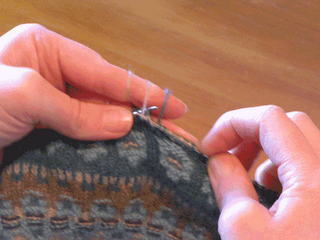
Blue shimmer bohus, no progress shot, I have knit all the increase rows for the back yoke, and now am working on the below the arm hole/syce section. I will have to stop dithering and come to a decision about waist shaping very soon. Bear confirmed last night that Rose collar was on the shoping list for my big '4-Oh how did that happen' in July, but both of us are a little easy-osey about delivering prezzies on time.
Knitting demo - how I knit and purl on my Bohus with the yarn in the left hand,
As mentioned in my last post, I am not suggesting this is the best way to knit and purl a Bohus. It is working fine for me, and gives me nice even tension with both yarns. Bohus knitting is famous for its use of both knit and purl stitches to give a textured effect to colour work as well as using three, four or more colours in a single row. When I was researching how to knit bohus found little info which demonstrated how to work colour where there was both knit and purl used. I have a copy of Poems of colour by Wendy Keele, but wanted to learn more about the techniques. Living in New Zealand knitting workshops are few and far between, i searched the net, I quizzed the gurus on knittersreview(see sidebar) and developed a technique which works. Eventually I developed a variation on the continental purl stitch shown in Sally Melvilles Purl Stitch book, and in this video here where it is called the Finish purl. No sadly I do not understand what I take to be Finish, but pictures are universal, and it really sounds pretty. i also aplogise for those with a dial up connection for the number of images in this post, but as a learner I was frustrated by sites that had a before and after shot of a knit technque or had line drawing of the needles with no indication of what the hands were doing.
Anyway, when I knit with two colours in my left hand, I hold the yarns as detailed two posts ago, and then to knit, I start by inserting my right knitting pin into the next stitch on the left needle.



When the knitting pin is through the stitch, I twist my right wrist so the pin is now vertical/pointing up, and scoop under the yarn,









I untwist my wrist bringing the point of the pin down and keeping the yarn under tension 'pop' the pin and yarn back thru the stitch.
Then I slide the stitch off the left needle, leaving the new stitch on the right pin, I tend to give a slight tug of the right knitting pin away from the yarn, at this stage to settle the new stitch in place.
To purl, I first 'lift' the purl yarn into place so it comes over the left knitting pin, this is not so much lifting the yarn as putting the left knitting pin under the yarn and lifting it up. Then I insert the right knitting pin purlwise into the next stitch on the left needle, the knitting pin needs to push through a good distance, so it can be twisted up and 'hook' the purl yarn.
Ater that I twist the right knitting pin down and slide the old stitch off the left pin leaving the newly formed stitch on the right needle. Some times I use my thumb tip to hold the yarn in place as I slip the yarn through the stitch.
I have learned to keep the yarn under tension while this happens, and do this in part by pinning the yarn against the left knitting pin or against a finger to stop it feeding so easily, I also roll my fingers away from the knitting. Most knitting diagrams show the left index finger raised to tension the yarn, but I find that causes me problems with tension and even feed.
No comments:
Post a Comment